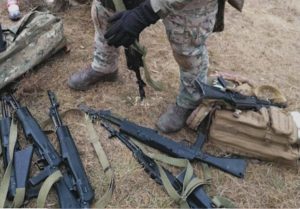
Russians are localizing the production of Shahed kamikaze drones
The Armed Forces of Ukraine outlined the differences between Russian and Iranian-made Shahed drones.
Captain Andriy Rudyk, a representative of the Center for the Research of Trophy and Prospective Weapons and Military Equipment of the General Staff of the Armed Forces of Ukraine, reported on this at a briefing at the Military Media Center.
In August, Militarnyi reported on the localization of the production of Shahed-136 kamikaze drones in Russia.
“We do not exclude the fact that the Russian Federation, looking for simple technical solutions and reducing the cost of materials and establishing the supply of substitute components, is trying to establish the production of this loitering munitions and make it mass-produced,” Rudyk said.

The changes in the drone’s design, recorded by the Center’s analysts, include:
- a fundamentally different warhead, which is now equipped with tungsten balls;
- replacement of the country of the powerplant manufacturer (MicroPilot UAV Flight Control Systems MD550 engine instead of Mado MD550);
- modification of the hull (a composite fuselage with a filler of the type of mounting foam is used to replace the one-frame fuselage);
- use of the new KST X30-12-165 servo motor;
- use of the Russian-made Kometa device in the navigation system.
Rudyk noted that drones do not fundamentally differ from earlier models, and the identified differences are of a minor nature and are due to the strive to reduce production costs.
The main countries of origin for the parts of the Russian version of the kamikaze drone are China, Switzerland, and the United States.
The parts have a production date between 2020 and 2023. Investigators from Conflict Armament Research documented that twelve parts were manufactured after the full-scale invasion started in February 2022.

At the same time, all Russian parts used in the UAV were manufactured between January and March 2023.
It is reported that the production of the Russian version of Shahed is being launched in the Alabuga Special Economic Zone in Tatarstan.
Within 2-3 years, the Russian Federation wants to replace a significant part of the components, train people, and organize the technological process.
The total cost of the project is estimated at RUB 115-130 billion ($1.28-1.45 billion).
SUPPORT MILITARNYI
Even a single donation or a $1 subscription will help us contnue working and developing. Fund independent military media and have access to credible information.


 Вероніка Грищенко
Вероніка Грищенко 
 Андрій Соколов
Андрій Соколов 
 Urich
Urich 
 Андрій Харук
Андрій Харук 
 Контужений Безпілотник
Контужений Безпілотник 

 Центр ініціатив ПЖ
Центр ініціатив ПЖ 



 Vadim Kushnikov
Vadim Kushnikov 
 Андрій Тарасенко
Андрій Тарасенко 
 Юрій Юзич
Юрій Юзич 




